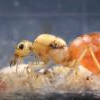Hello All! I caught what I think is my first queen in an odd situation earlier this morning...
Image Repository:
https://drive.google...EekkrjiaGV5cPVu
Location/Habitat: Suburban back yard, Northglenn, CO, USA - See collection notes at bottom...
Date: 5/11/18
Length: ~10mm
Coloration: Dark brown gaster, orange or dark orange body, legs and head
Distinguishing Characteristics: Appears to be hair free? Very sleek looking exoskeleton, shiny all over. One petiole node (hard to see in pictures), wasn't able to count antennae segments. Big hump back makes me think she is a queen?
Behavior: Ran from me to find cracks to hide in, did not seem to have a sense of direction involved with her fleeing. Initially tried to hide under a twig in a sidewalk crack, and then under some small rocks and clay around pill bugs. Once she found a "safe" feeling nook, she stayed right there until I uncovered her. Fleeing to a safe feeling crack also makes me think she is a queen?
Nest: None known in my area
Nuptial Flight: None known in my area
Collection notes: About 1 month ago, my husband and I bought a rosebush at our local Home Depot. We kept it inside from the date we bought it until today, when we brought it outside around 9am to plant it. It sat outside for about an hour. When I picked it up to bring it to my husband, that's when I noticed this ant! When she initially fled, she fled back INSIDE the packaging of the rosebush. After I got something to collect her with, I shook her out onto the sidewalk.
The packaging on the rosebush says Mea Nursery in Lindale, TX. Since she was living inside the rosebush packaging, and our rosebush sat indoors for about a month, it makes me wonder if she's not from Texas, or from anywhere between Lindale, TX and Denver, CO. Especially since there haven't been any distinctive reports of nuptial flights in Colorado yet this year.
Assuming she's from Colorado, I think she's most likely to be one of any number of Formica sp.? I'm really not sure, though, since I'm new to all of this! ![]() I'm a little concerned that, if she is from another place, she might have already been founding/laying eggs in the packaging for the rosebush (I didn't think to inspect it). So if she came out to greet the sunlight. maybe she was trying to forage? I dunno!
I'm a little concerned that, if she is from another place, she might have already been founding/laying eggs in the packaging for the rosebush (I didn't think to inspect it). So if she came out to greet the sunlight. maybe she was trying to forage? I dunno!
Colorado Antweb for convenience.
Looking forward to everyone's experienced opinions.
Happy Weekend!
Kayla
Edited by Waganga, May 30 2018 - 8:25 PM.


















